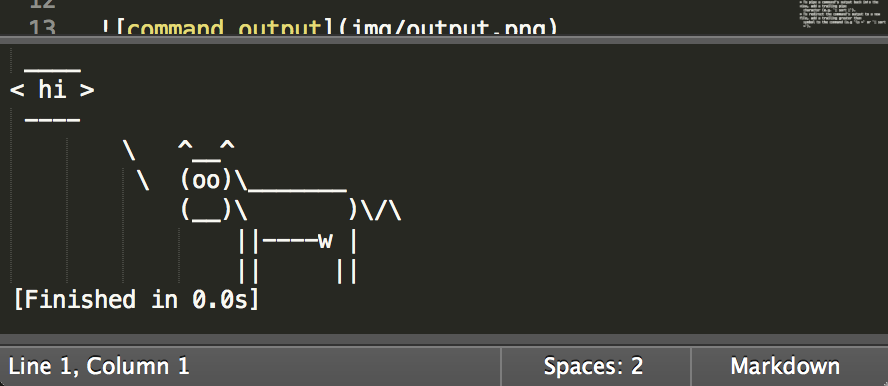Shell Turtlestein
Plugin for running arbitrary shell commands in Sublime Text
Details
Installs
- Total 33K
- Win 17K
- Mac 10K
- Linux 6K
| Dec 15 | Dec 14 | Dec 13 | Dec 12 | Dec 11 | Dec 10 | Dec 9 | Dec 8 | Dec 7 | Dec 6 | Dec 5 | Dec 4 | Dec 3 | Dec 2 | Dec 1 | Nov 30 | Nov 29 | Nov 28 | Nov 27 | Nov 26 | Nov 25 | Nov 24 | Nov 23 | Nov 22 | Nov 21 | Nov 20 | Nov 19 | Nov 18 | Nov 17 | Nov 16 | Nov 15 | Nov 14 | Nov 13 | Nov 12 | Nov 11 | Nov 10 | Nov 9 | Nov 8 | Nov 7 | Nov 6 | Nov 5 | Nov 4 | Nov 3 | Nov 2 | Nov 1 | |
|---|---|---|---|---|---|---|---|---|---|---|---|---|---|---|---|---|---|---|---|---|---|---|---|---|---|---|---|---|---|---|---|---|---|---|---|---|---|---|---|---|---|---|---|---|---|
| Windows | 0 | 0 | 0 | 0 | 1 | 0 | 0 | 0 | 1 | 0 | 0 | 0 | 0 | 0 | 0 | 0 | 0 | 0 | 1 | 0 | 0 | 0 | 0 | 0 | 0 | 0 | 0 | 0 | 0 | 0 | 0 | 2 | 0 | 0 | 0 | 0 | 0 | 0 | 0 | 1 | 0 | 0 | 0 | 0 | 0 |
| Mac | 0 | 0 | 0 | 0 | 0 | 0 | 0 | 0 | 0 | 0 | 0 | 0 | 0 | 0 | 0 | 0 | 0 | 0 | 0 | 0 | 0 | 0 | 0 | 0 | 0 | 0 | 1 | 0 | 0 | 0 | 1 | 0 | 0 | 0 | 0 | 1 | 0 | 0 | 0 | 0 | 0 | 0 | 1 | 0 | 0 |
| Linux | 0 | 0 | 0 | 0 | 0 | 0 | 1 | 0 | 0 | 0 | 0 | 0 | 0 | 0 | 0 | 1 | 0 | 0 | 0 | 0 | 0 | 0 | 0 | 0 | 0 | 0 | 2 | 0 | 0 | 0 | 0 | 0 | 0 | 0 | 0 | 0 | 0 | 0 | 0 | 0 | 0 | 1 | 1 | 0 | 0 |
Readme
- Source
- raw.githubusercontent.com
Shell Turtlestein
A quick and simple way to run arbitrary shell commands in Sublime Text.
Mr. Turtlestein acts as a more flexible alternative to Sublime's build systems. Commands run in your project's directory:

And display their output just like Sublime's build systems:

Input and output
Unix's familiar | and > operators can be used to pipe/redirect a command's
input and output:
- To pipe the active view's selections to a command, add a leading pipe
character (e.g.
| sort). If there are no non-empty selections the entire file will be piped to the command. - To pipe a command's output back into the view, add a trailing pipe
character (e.g.
| sort |). - To redirect the command's output to a new file, add a trailing greater than
symbol to the command (e.g
ls >or| sort >).
Using snippets
Snippets are available for frequently used commands. All snippets with the
scope name source.shell (source.dosbatch for Windows users) can be used in
the prompt shown above. I have
some examples
you can take a look at to get an idea for this.
Default keybindings
- Ctrl + Shift + C (Cmd + Shift + C): prompt for a shell command
- Ctrl + Alt + Shift + C (Cmd + Alt + Shift + C): launch a terminal in the window's directory
- Ctrl + Shift + X (Cmd + Shift + X): re-run the previous command
Optional Configuration
In your own Packages/User/Shell Turtlestein.sublime-settings file you can
override the following settings:
surround_cmd: A two-element array that specifies text to append before and after the command (e.g.["source ~/.profile && ", ""]).exec_args: The arguments that will be passed toExecCommand. The same options that are available to build systems are available here, butfile_regex,line_regex,encoding,env, andpathare the only options that make sense to use with this plugin. Arguments specified in thecmd_settings(see below) will override these defaults.cmd_settings: An array of configurations to use for commands that are executed. The first configuration to match the command being run will be used. The keys that each configuration should have are:cmd_regex: A regex that must match the command for this configuration for this configuration to be used.exec_argsandsurround_cmdoverride the settings described above for any matching command.
prefer_active_view_dir: If set to true, prefer using the directory of active file over using a folder open in the current project.
PAQ
Q: Who the balls is Shell Turtlestein?
A: He was a pet turtle that died in some episode of Modern Family. That's about as high-brow as my references get. R.I.P. Shell :(
Q: What does “PAQ” stand for?
A: Possibly asked questions
Thanks!
Thanks to all the contributors. I'd give you all high fives if my arm would fit through the internet.
